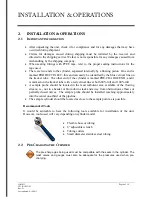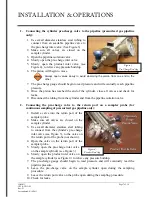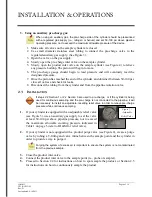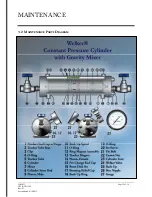
MAINTENANCE
IOM-013
Page 14 of 18
CP2 & CP5GM
Rev: D
Last updated: 4/14/2011
Figure 8 -
Piston Assembly
5.
Wipe down all other parts and dry carefully.
6.
Closely examine the honed surface of the cylinder. Scratches and pits will cause the seals
to leak.
The following are causes to return the device to the manufacturer:
Scratches or pitting that allow migration of gas from one side to the other.
Any damage to the outside cylinder shell that may compromise the cylinder wall
thickness
.
3.5
R
EASSEMBLY
I
NSTRUCTIONS
1.
Slide the mixing rod back into
the piston assembly and
reassemble the piston
assembly. (See Figure 8 at
right).
2.
Replace the piston inside the
cylinder carefully. Again, be
careful not to scratch the
cylinder or damage the seals,
and make sure that the
direction of piston insertion is
correct. The female end (Part
14) of piston goes toward the
pre-charge end cap (Part 15)
and the male end (Part 9) goes toward the product side end cap (Part 1).
3.
Carefully slide the cylinder (Part 6) to the pre-charge end cap (Part 13), then carefully
slide the six tie bolts (Part 17) back into the product end cap (Part 13) so that the nuts are
facing the outside of the end cap.
4.
Replace the tracker tube clips (Part 3), tracker tube magnet (Part 10), and the tracker tube
(Part 5), and slide the product end cap (Part 2) back onto the six tie bolts.
5.
Tighten the nuts (Part 1) to the correct torque using a cross bolting sequence:
Torque Specifications for Tie Bolts
Diameter of Tie Bolt
Foot Pounds
KG/M
3
/
8
” (CP-2, etc.)
5-6
.69-.82
1
/
2
” (CP-7, CP-24, etc.)
15-20
2.07-2.76
5
/
8
” (CP-5, etc.)
23-30
3.45-4.14
7
/
8
”or 1” (CP-11, LS-7, CP-80etc.)
55-65
7.60-8.98
6.
Pressure up cylinder at one end with an inert gas supply and test for leaks. Repeat the
process from the opposite end. Pressurize slowly to avoid the slamming the piston from
one end to the other.
Welker recommends using helium to test for leaks.




















